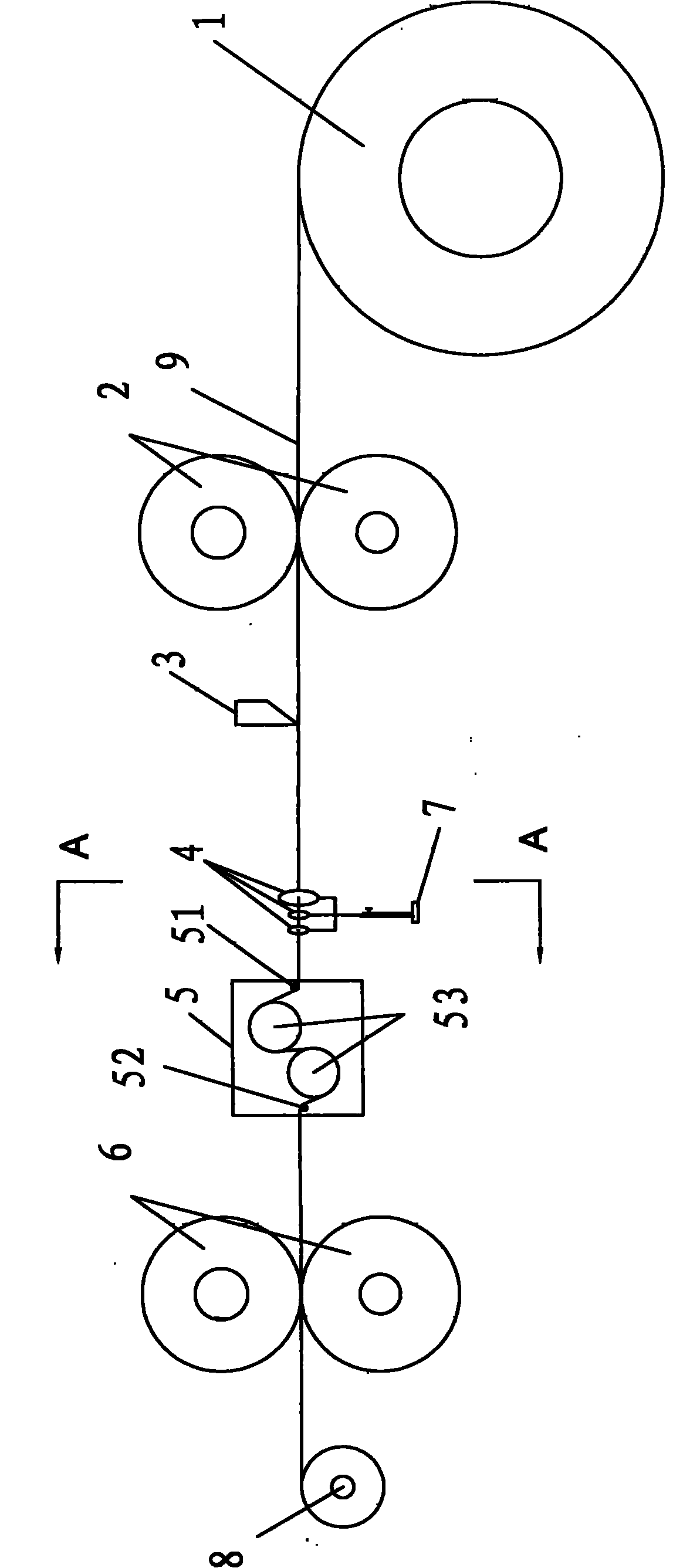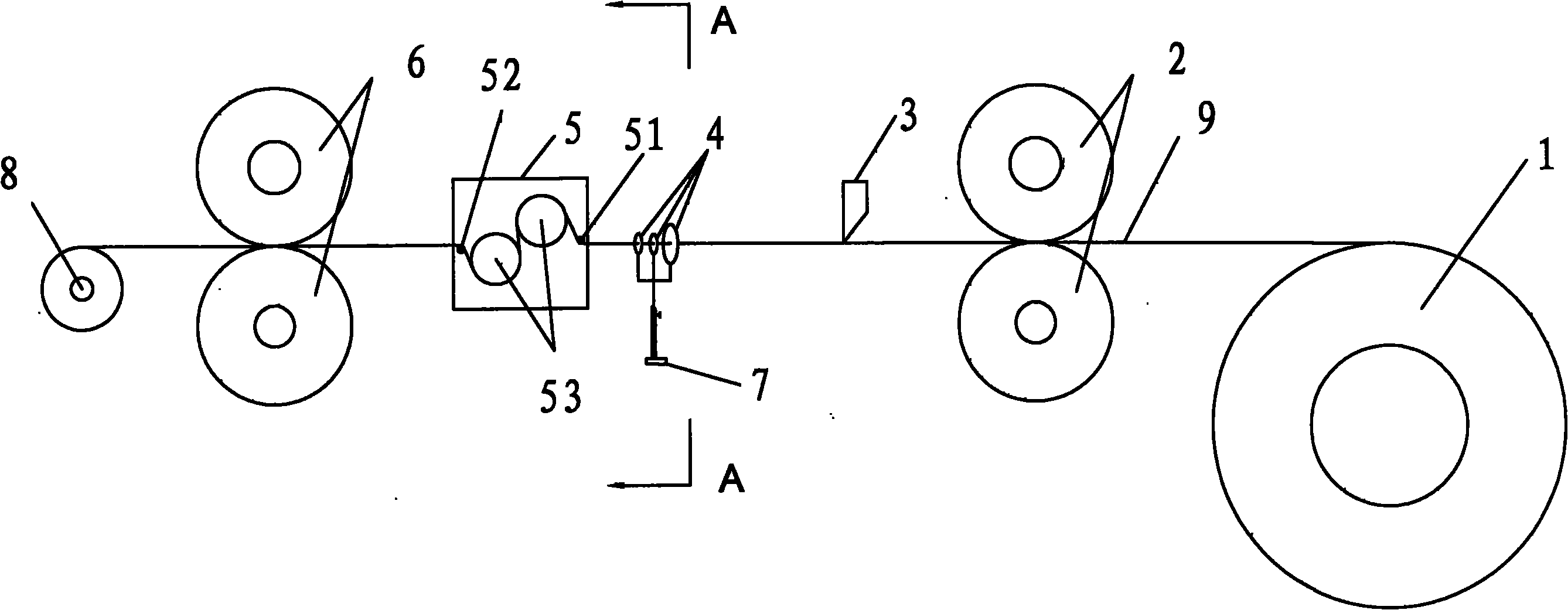Processing method of composite fabric
A processing method and technology of composite fabrics, which are applied in the directions of fabrics, textiles, non-woven fabrics, etc., can solve the problems of poor mechanical properties of membrane composite materials, and achieve the effects of simple processing, shortened construction period and improved strength.
- Summary
- Abstract
- Description
- Claims
- Application Information
AI Technical Summary
Problems solved by technology
Method used
Image
Examples
Example Embodiment
[0019] Example 1
[0020] A composite fabric processing method, which uses polypropylene fibers to make fiber webs by dry laying, and is thermally bonded by ultrasonic hot-melt bonding equipment to generate an areal density of 20g / m2. 2 of hot melt non-woven fabrics. The hot-melt non-woven fabric is softened and lubricated by polypropylene oil. The chemical composition of the oil includes 55% potassium cetyl phosphate, 11% polyoxyethylene oleate, 11% dimethicone, and sperm whale oil. twenty three%.
[0021] see figure 1 , the processed non-woven fabric 9 is unwound from the cloth roller 1, passed through a pair of traction rollers 2, and pulled to the cutter 3 of the cutting machine to be cut into cloth strips with a width of 2 cm, and each cloth strip after cutting is cut through Pass 3 round guide wire loops 4. combine figure 2 , 3 guide wire loops 4 along the cloth strip advancing direction, the diameter changes from large to small. The three wire guide rings 4 are f...
Example Embodiment
[0027] Embodiment 2
[0028] A composite fabric processing method, which uses polypropylene masterbatch to form a masterbatch layer net of uniform thickness, and is thermally bonded by ultrasonic hot-melt bonding equipment to generate an areal density of 50g / m2. 2 of non-woven fabrics. The hot-melt non-woven fabric is softened and lubricated by a polypropylene oil agent. The chemical composition of the oil agent includes 55% potassium cetyl phosphate; 11% polyoxyethylene oleate; 11% dimethicone; sperm whale Oil 23%.
[0029] The treated non-woven fabric 9 is unwound from the cloth roller 1, passed through a pair of traction rollers 2, and pulled to the cutter 3 of the cutting machine to be cut into cloth strips with a width of 1.5 cm. Pass through 3 circular wire guide rings 4. The diameters of the 3 wire guide wire rings 4 vary from large to small along the advancing direction of the cloth strip. The flat cloth strip is compressed and drawn into a circular thread by the wi...
Example Embodiment
[0032] Embodiment 3
[0033] A composite fabric processing method, using ES fiber produced by Japan Chisso Corporation, making a fiber web by dry laying, and thermal bonding by ultrasonic hot-melt bonding equipment to generate an areal density of 100g / m2 2 of hot melt non-woven fabrics. The hot-melt non-woven fabric is polyester oil No. 1, and the chemical composition of the oil agent includes 16% oleic acid, 8% triglycolic acid, 2% lanolin, 3% glycerin, and 71% white oil.
[0034] The treated non-woven fabric 9 is unwound from the cloth roller 1, passed through a pair of traction rollers 2, and pulled to the cutter 3 of the cutting machine to be cut into cloth strips with a width of 2 cm, and each cloth strip after cutting passes through. 3 circular wire guide rings 4. The diameter of the 3 wire guide rings 4 varies from large to small along the advancing direction of the cloth strip. The flat cloth strip is compressed and drawn into a circular thread by the wire guide ring...
PUM
| Property | Measurement | Unit |
|---|---|---|
| Width | aaaaa | aaaaa |
| Areal density | aaaaa | aaaaa |
| Areal density | aaaaa | aaaaa |
Abstract
Description
Claims
Application Information
 Login to view more
Login to view more - R&D Engineer
- R&D Manager
- IP Professional
- Industry Leading Data Capabilities
- Powerful AI technology
- Patent DNA Extraction
Browse by: Latest US Patents, China's latest patents, Technical Efficacy Thesaurus, Application Domain, Technology Topic.
© 2024 PatSnap. All rights reserved.Legal|Privacy policy|Modern Slavery Act Transparency Statement|Sitemap



